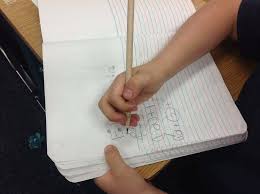Why cant my child write legibly
D y s g r a p h i a
School Term :(SLD - Specific Learning Disability)
 Challenges: 1 or more
Challenges: 1 or more
- letter inconsistencies
- letter formation and/or legibility
- mixture of upper/lower case letters or print/cursive letters
- irregular letter sizes and shapes
- rate or speed of writing
- unfinished letters
- struggle to use writing as a communications tool
- grammer and punctuation
- spelling
- fine motor skills
Dysgraphia is not . . .
- laziness
- not trying
- not caring
- sloppy writing
- general sloppiness
- careless writing
- visual-motor delay
 Children with dysgraphia may find it difficult to hold a pen or pencil. They may find it hard to line up letters as they should, even with the help of lined paper. They may also have trouble spelling words or taking the thoughts in their heads and putting them down in writing.
Children with dysgraphia may find it difficult to hold a pen or pencil. They may find it hard to line up letters as they should, even with the help of lined paper. They may also have trouble spelling words or taking the thoughts in their heads and putting them down in writing.
Dysgraphia, like other learning difficulties, has nothing to do with intelligence or motivation but with how the brain processes the information it receives. It’s a condition that never goes away, though there are methods and tools to improve writing. A child may have other learning difficulties along with dysgraphia, for instance, dyslexia, dyspraxia, language disorders, or ADHD.
 Dysgraphia is defined as a difficulty in automatically remembering and mastering the sequence of muscle motor movements needed in writing letters or numbers. This difficulty is out of harmony with the person's intelligence, regular teaching instruction, and (in most cases) the use of the pencil in non-learning tasks. It is neurologically based and exists in varying degrees, ranging from mild to moderate. It can be diagnosed, and it can be overcome if appropriate remedial strategies are taught well and conscientiously carried out. An adequate remedial program generally works if applied on a daily basis. In many situations, it is relatively easy to plan appropriate compensations to be used as needed.
Dysgraphia is defined as a difficulty in automatically remembering and mastering the sequence of muscle motor movements needed in writing letters or numbers. This difficulty is out of harmony with the person's intelligence, regular teaching instruction, and (in most cases) the use of the pencil in non-learning tasks. It is neurologically based and exists in varying degrees, ranging from mild to moderate. It can be diagnosed, and it can be overcome if appropriate remedial strategies are taught well and conscientiously carried out. An adequate remedial program generally works if applied on a daily basis. In many situations, it is relatively easy to plan appropriate compensations to be used as needed.
Dysgraphia is an inefficiency that seldom exists in isolation without other symptoms of learning problems. While it may occasionally exist alone, it is most commonly related to learning problems involved within the sphere of written language. Difficulty in writing is often a major problem for students, especially as they progress into upper elementary and into secondary school. Rosa Hagan has stated, "Inefficiency in handwriting skills provides a barrier to learning, whereas efficiency in basic handwriting skills provides a tool for learning. Once this tool is established, it can help reinforce many other areas kids are having difficulties with."

Difficulties with writing often lead to major misunderstandings by teachers and parents and, consequently, to many frustrations for the student. This is especially true for the bright, linguistically fast student who encounters a major stumbling block when dealing with written expression due to the lack of smooth, efficient automaticity in letter and word formation. These students struggle to translate their thoughts and knowledge, which then denies their teachers the opportunity to understand what they know.
A substitute teacher or parent may suspect dysgraphia in a student by observing writing performances. All too often, however, the student's performance is interpreted as poor motivation, carelessness, laziness, or excessive speed. While these observations may be very real, they are on the surface, and the underlying cause may be a dysgraphic pattern which is not within the student's control.
www.dyslexia-ca.org/dysgraphia.htm


